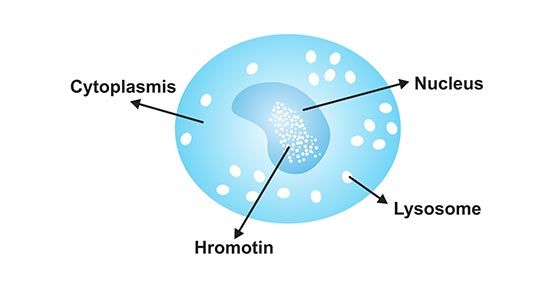Monocytes Cytokines
Once we mention the monocytes, macrophages will come to our mind. As mentioned on the article titled “Macrophages Cytokines”, macrophages are white blood cells located in tissues, derived from monocytes. That is, monocytes can differentiate to macrophages under certain condition. Accumulating studies have revealed that cytokines produced by monocytes play a key role in the process of differentiation. So what difference between monocytes and macrophages? And what cytokines play a critical role during the differentiation?
What are Moncytes?
Before knowing the difference between monocytes and macrophages, we introduce the moncytes firstly. Monocytes, a type of white blood cell, are derived from hematopoietic stem cells in the bone marrow. Monocytes are the largest volume of white blood cells in the blood, with diameters ranging from 14μm to 20μm. They are round in the bloodstream (Figure 1). Monocytes are formed in the bone marrow and are released into peripheral blood, where they circulate for several days. When they enter the blood from the bone marrow, they are still immature cells. Monocytes are an important part of the body's defense system. It has obvious deformation movement and can engulf and remove injured and aging cells and their fragments. Monocytes also have the ability to recognize and kill tumor cells.

Figure 1. The typical structure of moncytes.
What Difference Between Monocytes and Macrophages?
Monocytes have a good ability to deform. After staying in the bloodstream for 1 to 5 days, they across the blood vessels and then differentiate into macrophages. The difference between them are as follows:
- Difference between monocyte and macrophage presence: Monocytes are found in the blood, while macrophages are found in the extracellular fluid.
- Diameter: Diameter of a monocyte is around 7.72-9.99 μm, but a macrophage is 21 μm.
- Receptors: Monocytes contain CD14 and CD16 on the surface of the cell. But macrophages contain CD14, Cd11b, CD68, MAC-1 and -3, EMR1 and lysozyme M on the surface of the cells.
- Function: Monocytes are involved in the innate immunity by differentiating into macrophages. They are involved in the adaptive immunity by secreting cytokines and chemokines. Macrophages are involved in the innate immunity as well as the adaptive immunity by presenting the antigens of the foreign bodies on their MHC complex.
What Cytokines Play a Critical Role During The Differentiation?
Resident macrophages are usually not adequate to remove foreign material from the body because of their limited number and localization in tissues and body cavities. However, as soon as an infection or tissue injury occurs, circulating monocytes in blood migrate to these sites and differentiate into exudate macrophages. These cells, often together with T lymphocytes, then form an inflammatory exudate. Monocytes traverse the endothelial lining of the vessel walls, thus ensuring maintenance of the resident macrophage population.
Cytokines is stimulated during interaction between monocytes and macrophages and bacteria or bacterial cell wall products, such as LPS. Stimulated monocytes and macrophages produce activating cytokines, such as IL1, IL6, 1L8, IL12 and TNFɑ, and deactivating cytokines such as TGFP and IL10. These cytokines stimulate or inhibit the oxidative and non-oxidative microbicidal activities of monocytes and macrophages in an autocrine or paracrine fashion.


